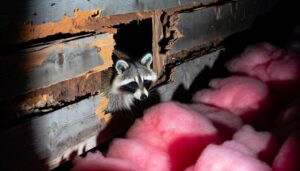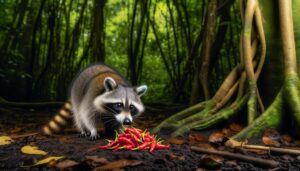How Do Raccoons Live in Alaska?
Raccoons, traditionally not associated with Alaska's diverse climate, have been sporadically documented within the state. These adaptive omnivores, known for their distinctive facial masks and ringed tails, have been observed in regions like Anchorage, the Kenai Peninsula, and Southeastern Alaska.
Raccoons exhibit remarkable flexibility in their diet and shelter preferences, enabling them to survive in harsh Alaskan environments. Their thick fur provides necessary insulation against extreme cold, and they exploit a variety of resources for sustenance.
Despite challenges like severe weather and predation, raccoons demonstrate an occasional but notable presence in Alaska. Discover further insights by continuing with the information provided.
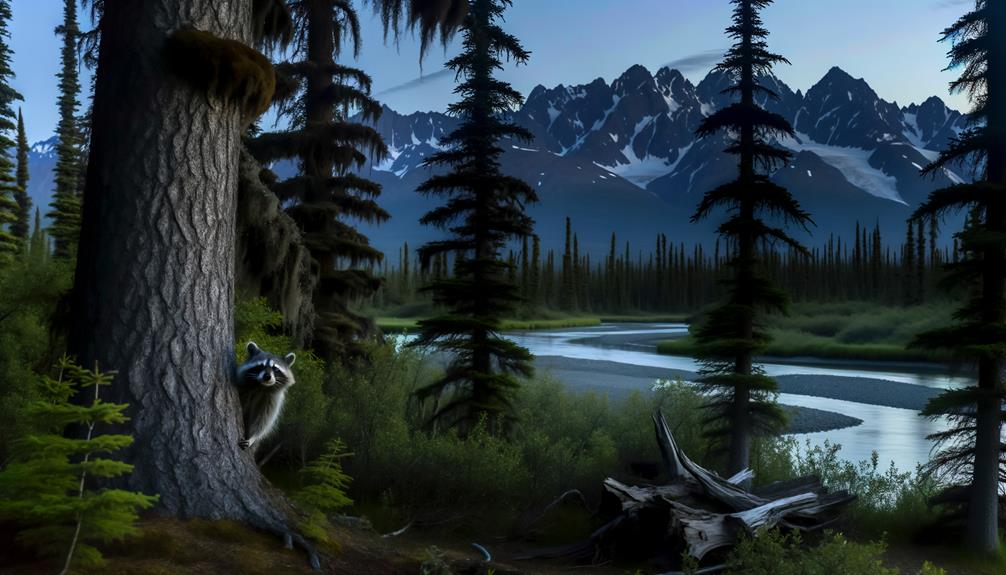
Key Takeaways
- Raccoons have been sighted in various regions of Alaska, including Anchorage and the Kenai Peninsula.
- Physical evidence such as tracks, scat, and fur confirms their presence in these areas.
- Experts support the sporadic but consistent sightings of raccoons in Alaska.
- Raccoons adapt by foraging for diverse food sources and seeking insulated shelters.
- Their thick fur and flexible diets help them survive Alaska's harsh climate.
Raccoons in North America
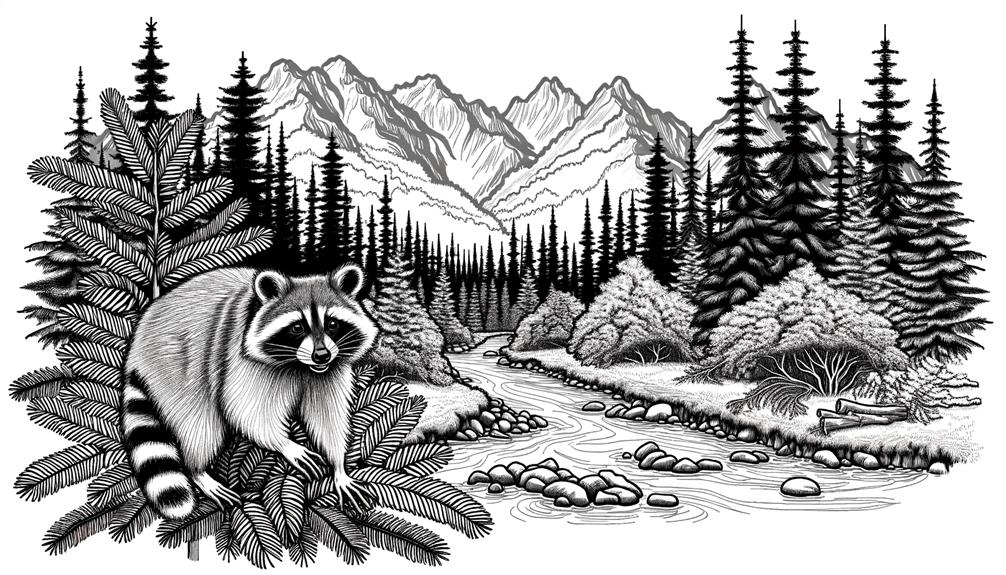
Raccoons, scientifically known as Procyon lotor, are highly adaptable mammals found throughout North America, from southern Canada to Panama. These omnivorous creatures thrive in diverse habitats, including forests, suburban areas, and urban environments. Their distinctive black facial mask and ringed tail make them easily recognizable.
Raccoons are opportunistic feeders, consuming a varied diet that includes fruits, nuts, insects, small mammals, and human refuse. Their dexterous front paws allow for intricate manipulation of food and objects. Despite their adaptability, raccoons face challenges such as habitat loss and vehicle collisions.
Their population density is highest in regions with abundant food sources and shelter. Understanding raccoon distribution and behavior is essential for effective wildlife management and coexistence strategies.
Alaska's Unique Climate
Given its vast size and geographical position, Alaska experiences a unique and varied climate that ranges from temperate rainforests in the southeast to arctic tundra in the north. This climatic diversity is influenced by several factors, including latitude, elevation, and proximity to the ocean. For instance, the southeast experiences mild temperatures and high precipitation, while the interior endures extreme seasonal temperature variations. In contrast, the northern regions exhibit permafrost and minimal precipitation. Understanding these climatic zones is essential for examining the potential habitats for various species.
| Region | Climate Characteristics |
|---|---|
| Southeast | Temperate rainforest, high precipitation |
| Southcentral | Maritime, moderate temperatures |
| Interior | Continental, extreme temperature variations |
| Southwest | Maritime, cool and wet |
| Northern (Arctic) | Tundra, permafrost, minimal precipitation |
This extensive climatic framework underscores the complexities of Alaska's environmental conditions.
Habitat Preferences
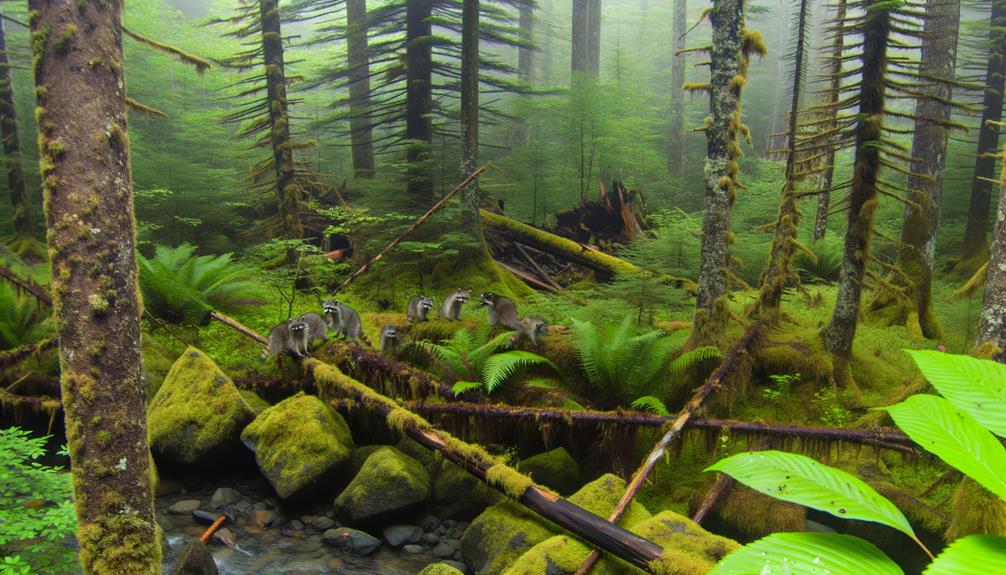
Raccoons exhibit a marked preference for habitats that offer both abundant food sources and secure den sites, which can be found in both urban and rural environments.
These animals are highly adaptable, utilizing a variety of shelters such as tree cavities, abandoned burrows, and even human structures.
Understanding the specific habitat preferences of raccoons is essential for evaluating their potential presence in regions with diverse climatic conditions, such as Alaska.
Urban Vs. Rural Areas
Frequently observed in urban environments, raccoons demonstrate a remarkable adaptability to various habitats, including rural areas, where they exploit different resources and shelter opportunities.
Urban settings provide raccoons with abundant food sources such as garbage, pet food, and garden produce, while also offering numerous hiding spots in buildings and sewer systems.
In contrast, rural areas present a different set of resources and challenges, where raccoons rely on natural food sources and landscape features.
Key distinctions between urban and rural raccoon habitats:
- Food Availability: Urban areas offer human-related food sources; rural areas depend on natural foraging.
- Shelter Options: Urban environments have artificial structures; rural areas utilize natural formations.
- Human Interaction: Higher in urban settings, minimal in rural locales.
Den Sites and Shelters
Den sites and shelters for raccoons display significant variability, depending on the availability of natural and artificial structures within their habitat. In forested regions, raccoons typically use hollow trees, logs, and abandoned dens created by other animals.
Urban environments offer a different set of opportunities, where raccoons might seek refuge in attics, basements, or under decks. The species demonstrates a remarkable adaptability, selecting den sites that provide protection from predators and harsh weather conditions.
In Alaska, however, the harsh climatic conditions and limited availability of suitable shelters may impact their presence and distribution. Understanding these habitat preferences is essential for evaluating raccoon populations and their ecological roles in diverse environments, including potential changes due to urban expansion and climate shifts.
Predators and Threats
In the diverse ecosystems of Alaska, raccoons face an array of natural predators and environmental threats that impact their survival and behavior. The challenging Alaskan terrain and climatic conditions present significant hurdles for raccoons, potentially limiting their population density and geographical spread.
Key threats include:
- Predators: Raccoons are susceptible to predation by larger carnivores such as wolves, bears, and coyotes, which are prevalent in Alaskan habitats.
- Harsh Climate: Extreme cold and heavy snowfall can affect raccoons' ability to find food and shelter, thereby impacting their survival rates.
- Human Activity: Urban expansion, road traffic, and hunting can also pose substantial risks, disrupting raccoon habitats and increasing mortality rates.
These factors collectively influence the ecological niche raccoons might occupy in Alaska.
Sightings and Evidence
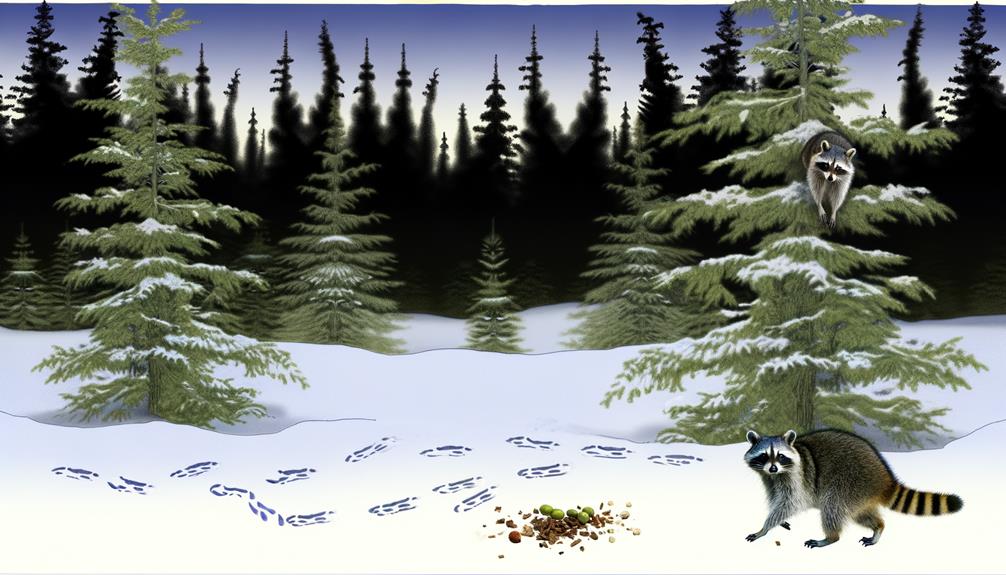
Recent reports of raccoon sightings in Alaska have prompted a thorough examination of available evidence, including photographic and physical traces such as tracks and scat.
Wildlife experts have weighed in on the plausibility of these sightings, analyzing the environmental and ecological factors that could support or refute the presence of raccoons in the region.
This section will present a synthesis of recent Alaskan sightings, physical evidence, and expert opinions to assess the likelihood of raccoons residing in Alaska.
Recent Alaskan Sightings
Numerous reports and photographic evidence have surfaced over the past few years, indicating that raccoons may be establishing a presence in various regions of Alaska. Observations have been sporadic but consistent, suggesting a possible adaptation to the state's harsh environments.
Notable sightings include:
- Anchorage Area: Several residents have reported raccoon sightings near urban areas, often capturing images of the animals scavenging.
- Kenai Peninsula: Wildlife enthusiasts have documented raccoons in more rural settings, pointing to an expanding range.
- Southeastern Alaska: Sightings near coastal regions have been supported by photographs, indicating raccoons may be utilizing maritime resources.
These observations warrant further investigation to understand the potential implications for local ecosystems and wildlife management strategies.
Physical Evidence Found
Building on these anecdotal reports, concrete physical evidence has begun to emerge, corroborating the presence of raccoons in Alaska. Recent findings include tracks identified by wildlife biologists, consistent with those of Procyon lotor.
Photographic evidence from motion-activated trail cameras has captured raccoons near Anchorage and Fairbanks. Additionally, scat samples analyzed through DNA sequencing have confirmed raccoon presence in these regions.
These findings are further supported by recovered fur samples and partial skeletal remains, which match raccoon morphology. The collection of such tangible evidence strengthens the case for raccoons inhabiting Alaska, suggesting either a recent migration or an overlooked, established population.
This data provides a foundation for further ecological and behavioral studies on raccoon adaptation to Alaskan environments.
Wildlife Expert Opinions
A myriad of wildlife experts have weighed in on the sightings and physical evidence, offering professional opinions that substantiate the presence of raccoons in Alaska. Detailed analyses have been conducted, examining various forms of evidence such as sightings, tracks, and photographic documentation. These experts provide a strong argument for the occasional appearance of raccoons in Alaska, despite the harsh climate.
- Sightings: Multiple credible reports from residents and scientists indicate sporadic raccoon sightings across different regions in Alaska.
- Tracks: Identifiable raccoon tracks have been documented in areas where sightings have occurred, supporting the visual evidence.
- Photographic Evidence: Clear images captured by wildlife cameras and residents further validate these claims, showing raccoons in various Alaskan habitats.
These findings collectively suggest a limited but notable presence.
Adaptation Strategies
Raccoons in Alaska employ various adaptation strategies to survive the region's harsh climatic conditions and scarce food resources. These intelligent mammals exhibit remarkable flexibility in their diet and behavior. They forage extensively, consuming a diverse range of food including insects, small mammals, and plant material to meet their nutritional needs. Their thick fur provides essential insulation against the extreme cold, and they often seek shelter in hollow trees or abandoned burrows to stay warm.
| Adaptation Strategy | Emotional Impact |
|---|---|
| Diverse Diet | Resilience |
| Thick Fur | Survival |
| Shelter Seeking | Resourcefulness |
| Extensive Foraging | Determination |
These strategies highlight the raccoon's incredible ability to adapt and thrive even in one of the most challenging environments on Earth.
Conclusion
To sum up, raccoons, commonly found across North America, exhibit limited presence in Alaska due to the region's unique climate and habitat preferences. While sightings and evidence of raccoons exist, the harsh environmental conditions and presence of predators pose significant threats.
Adaptation strategies employed by raccoons include altering foraging behaviors and modifying shelter choices. Despite these strategies, the challenges presented by Alaska's distinct ecological landscape make sustained raccoon populations in the region unlikely.


